Understanding How ABA Fosters Concentration and Attention in Autism
Applied Behavior Analysis (ABA) is a pioneering, evidence-based approach that significantly aids children with autism in improving their focus and concentration. By breaking down complex skills into manageable steps, using positive reinforcement, and creating structured environments, ABA therapy helps unlock each child's potential for sustained attention and engagement. This article explores how ABA systematically enhances attention skills, addresses contributing factors, and provides tailored interventions to support children’s developmental journeys.
The Foundations of ABA Therapy and Its Focus on Attention
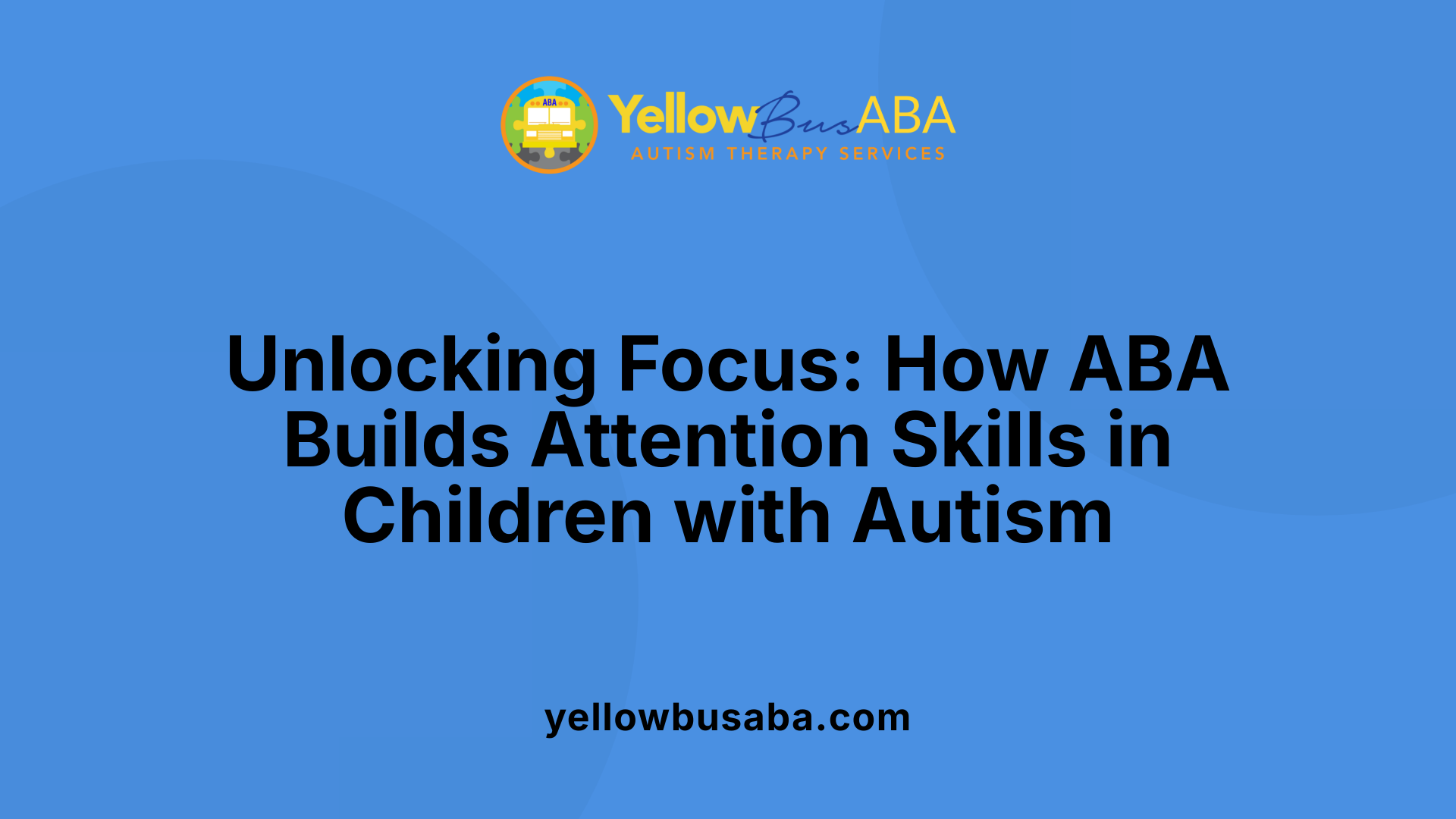
What role does ABA therapy play in improving cognitive focus and concentration in children with autism?
ABA, or Applied Behavior Analysis, is a proven, evidence-based approach that significantly supports children with autism in developing their attention skills. It employs a range of behavioral techniques customized to each child's unique needs, focusing on reinforcing desirable behaviors and teaching new skills.
One of the core strategies of ABA is breaking tasks into small, manageable parts. This helps children concentrate on one aspect at a time, gradually building their ability to sustain focus over longer periods. Therapists use positive reinforcement—such as praise, preferred toys, or engaging activities—to motivate children, linking focus with positive outcomes and fostering a willingness to participate.
ABA also incorporates visual supports, structured routines, and clear cues to create an environment conducive to focused learning. Routines that are predictable help reduce distractions, making it easier for children to understand expectations and feel secure. This structured setting encourages consistent attention and engagement across various activities.
Furthermore, ABA addresses foundational challenges like communication and sensory sensitivities, which can interfere with concentration. By improving social skills and teaching appropriate responses, ABA reduces frustration and behavioral barriers, allowing children to focus better on learning tasks.
Techniques such as prompting, fading, and chaining are employed to teach attention and communication skills systematically. Data collection during therapy sessions tracks progress through metrics like duration of focused attention and success rate in completing tasks, ensuring that interventions remain effective and tailored.
Recent research by Asadi et al. (2024) highlights that visual modeling and explicit attention cues further enhance the effectiveness of ABA strategies in improving focus. These systematic approaches, combined with caregiver collaboration and consistency across settings, help children develop longer attention spans.
In summary, ABA therapy plays a crucial role in fostering sustained attention in children with autism by creating structured, engaging, and supportive learning environments. Its individualized techniques help children overcome attentional challenges, enabling them to participate more fully in social, educational, and daily activities.
| Technique | Approach | Purpose |
|---|---|---|
| Task Breakdown | Dividing tasks into smaller steps | Builds confidence and focus progressively |
| Positive Reinforcement | Reward positive behaviors | Encourages repetition of desired behaviors |
| Visual Supports | Use of pictures, cues | Facilitates understanding and attention |
| Routine and Structure | Predictable schedules | Reduces distractions and anxiety |
| Prompting and Fading | Guided assistance and gradual independence | Teaches specific skills systematically |
| Data Tracking | Recording progress measures | Ensures individualized, effective interventions |
How ABA addresses core challenges like communication and sensory processing
ABA therapy targets essential developmental aspects such as communication, social skills, sensory sensitivities, and self-care. By using behaviorally based teaching methods, ABA helps children improve their ability to express needs, initiate interactions, and manage sensory overloads.
For communication, Verbal Behavior Therapy (VBT) categorizes language into operants like mands (requests), tacts (comments), and intraverbals (conversational exchanges). This structured focus builds functional language, especially when combined with augmentative devices like PECS for non-verbal children.
Sensory processing issues, which often lead to hyper- or hypo-reactivity, are addressed through sensory integration techniques combined with ABA. These approaches aim to reduce sensitivities and help children adapt to diverse sensory inputs, improving overall daily functioning.
By identifying triggers for problem behaviors—such as aggression or self-injury—ABA intervenes with reinforcement of alternative actions and environmental modifications. Teaching children to manage their sensory environment comfortably and communicate effectively reduces behavioral challenges.
ABA also employs social stories and peer-mediated strategies to enhance social understanding and appropriate interactions. These interventions support children in navigating social norms, participating in group activities, and building relationships.
Overall, ABA’s comprehensive approach supports multiple developmental domains, addressing challenges in communication, sensory processing, and behavior. It aims to make daily experiences more manageable and enriching for children with autism, fostering independence and confidence.
| Focus Area | Technique | Outcome |
|---|---|---|
| Communication | Verbal Behavior, AAC | Functional language and social skills |
| Sensory Processing | Sensory integration, environmental modifications | Reduced sensitivities, better daily adjustment |
| Behavior Management | Reinforcement, social stories | Improved behavior, social participation |
| Social Skills | Peer modeling, social stories | Enhanced interaction and cooperation |
This integrated approach underpins ABA’s effectiveness in helping children with autism thrive across a range of developmental and behavioral challenges, leading to more engaged participation in every part of life.
Key Techniques of ABA to Enhance Attention and Focus
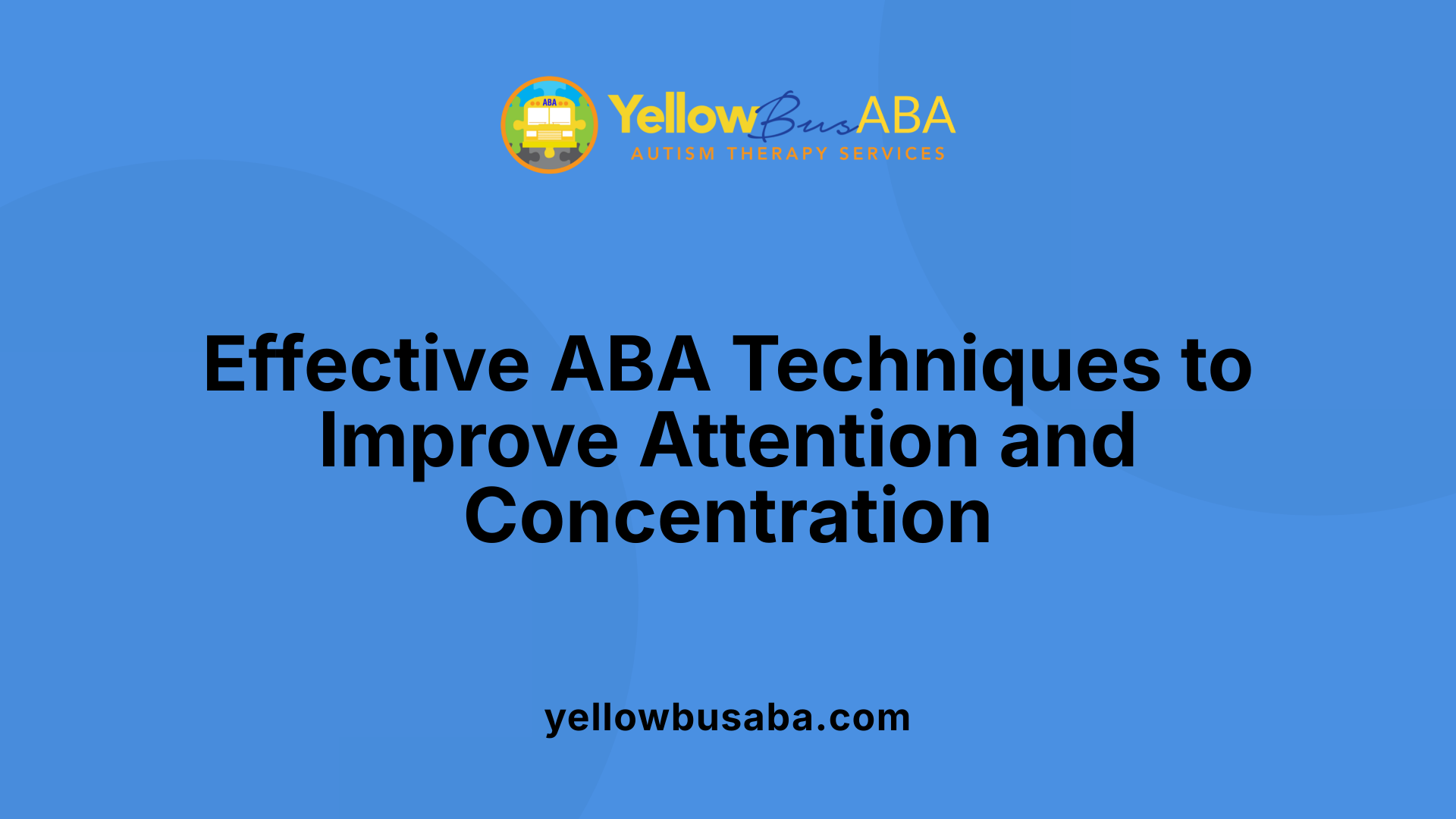
How does ABA therapy improve attention and focus in children with autism?
ABA therapy enhances attention and focus by employing a variety of structured, evidence-based strategies tailored to each child's needs. One fundamental approach is breaking down complex tasks into small, manageable steps—this task analysis helps children focus on one element at a time, building their confidence and concentration gradually.
Positive reinforcement is central to ABA. When children focus and engage in desired behaviors, they are rewarded with praise, toys, or activities they enjoy. This association encourages children to sustain their attention, as they begin to anticipate positive outcomes from their efforts.
Structured routines within ABA sessions provide predictability, which reduces distractions and creates a secure environment. Children come to understand expectations and learn to concentrate on tasks without feeling overwhelmed.
Furthermore, ABA integrates naturalistic and play-based methods. These include activities like storytelling, arts and crafts, and physical games, which are inherently engaging and help generalize attention skills to everyday settings.
Recent advancements such as joint attention training and peer-mediated activities specifically target skills like orienting to social stimuli and shifting focus between people and objects — essential components for social interaction and communication.
Sensory integration strategies and sensory-friendly environments are also incorporated to assist children who experience sensory overload. These modifications help children better manage sensitivities that could otherwise hinder their ability to focus.
In addition, visual supports, prompts, and modeling are used extensively. Visual schedules or cues provide clear, visual guidance about what to do next, reducing uncertainty. Modeling demonstrates desired behaviors for children to imitate, fostering spontaneous, independent attention.
Environmental control techniques, such as controlling noise levels and minimizing visual clutter, are used to help children stay engaged without being overwhelmed.
Activities like sorting, memory games, obstacle courses, and story-based tasks are designed to be engaging, encouraging sustained attention and cognitive engagement.
Overall, ABA combines behavioral procedures, communication development, sensory management, and environmental modifications to systematically improve attention and focus. The therapy's adaptability makes it suitable for a broad range of needs and helps children with autism develop longer attention spans over time.
What specific ABA techniques are used?
| Technique | Description | How it improves attention |
|---|---|---|
| Discrete Trial Training (DTT) | Short, structured learning trials with clear cues and immediate reinforcement | Focuses attention through repetition and immediate feedback |
| Pivotal Response Treatment (PRT) | Child-initiated activities with natural reinforcement | Encourages spontaneous attention and motivation |
| Visual Supports and Prompts | Pictures, schedules, or cues guiding the child's focus | Reduces ambiguity, enhances understanding and focus |
| Modeling and Imitation | Demonstrating desired behaviors for children to copy | Builds attention to social and communication cues |
| Natural Environment Teaching (NET) | Learning in real-life settings with functional activities | Generalizes attention skills to daily life |
Incorporating visual supports, prompts, and modeling for attention training
Visual supports—like picture schedules and cue cards—help children understand task expectations clearly. Prompts, including gestures or verbal hints, guide attention toward desired behaviors. Over time, these prompts are faded out as the child gains independence.
Modeling demonstrates attention behaviors through demonstrations by therapists or peers, encouraging children to imitate these behaviors, which fosters spontaneous engagement.
Incorporating naturalistic and play-based methods
Naturalistic approaches embed learning in daily routines and play activities, making them engaging and meaningful. Games like memory matching, obstacle courses, and storytelling naturally target attention skills while also promoting social and cognitive development.
These methods are effective because they mimic real-life interactions, helping children transfer learned attention skills outside structured therapy sessions. They also leverage the child's interests, which increases motivation and engagement.
By combining these strategies, ABA creates a comprehensive framework for building sustained attention, reducing sensory sensitivities, and fostering independence for children with autism.
The Role of Structured Routines and Environment in Attention Development
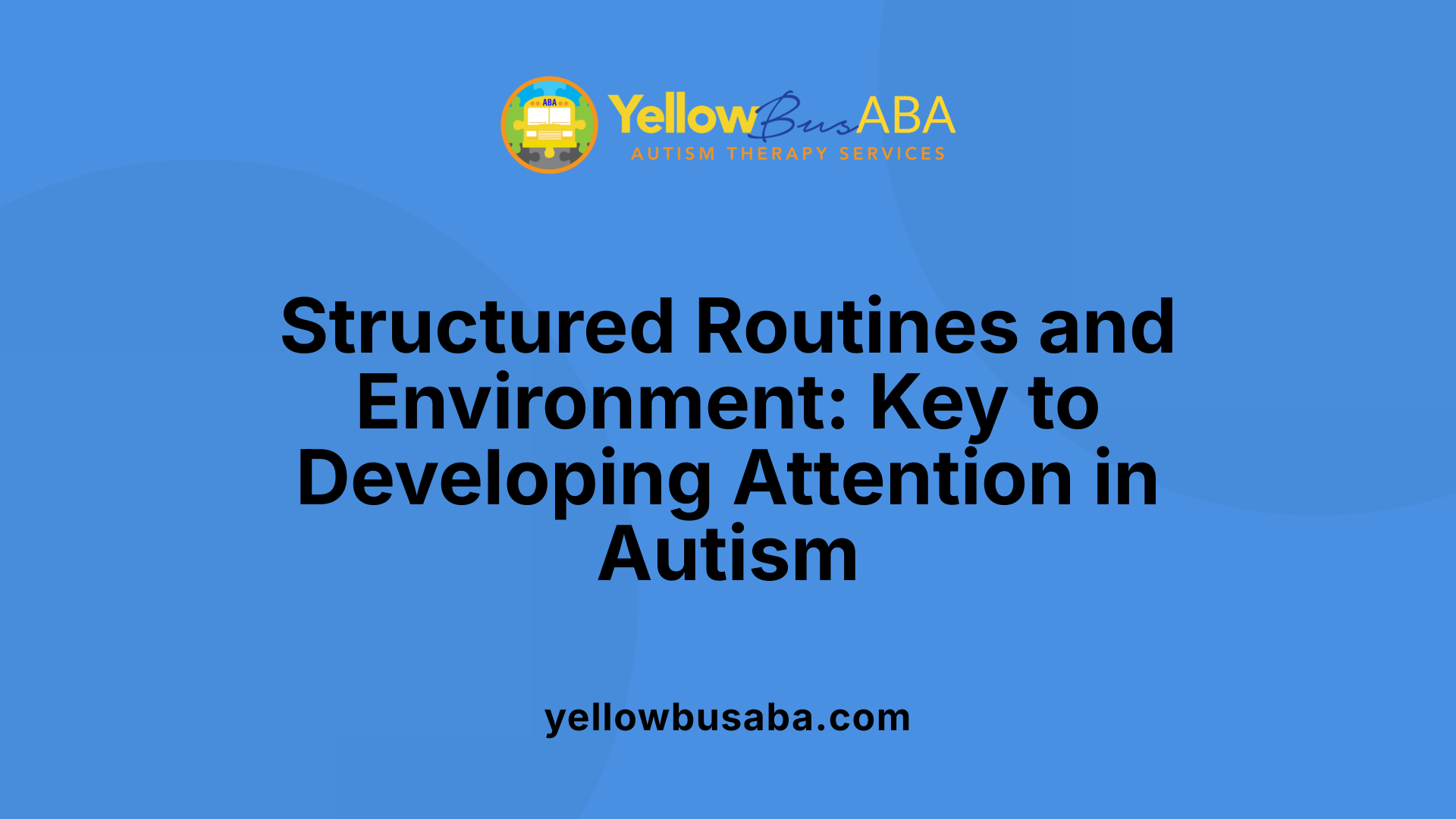
How does ABA therapy support attention span development in children with autism?
ABA therapy plays a crucial role in helping children with autism improve their attention span. It does so by teaching children to focus on tasks through the use of reinforcement strategies and carefully planned activities. Therapists often break down complex skills into smaller, manageable steps, enhancing the child's ability to concentrate and sustain focus.
Structured activities such as sorting objects, memory matching games, storytelling, and arts and crafts are incorporated into therapy sessions. These activities are designed to be engaging and progressive, gradually increasing in complexity to challenge and develop attention skills. Visual supports like picture schedules and cues are also used to help children understand what to expect, further promoting focus.
Creating a predictable environment is vital. ABA emphasizes establishing routines that children can anticipate, which reduces anxiety and sensory overload. When children know what to expect, they feel more secure and are more likely to engage actively with tasks. This consistency minimizes distractions and helps children learn to regulate their attention.
In addition to routine and activity structure, sensory considerations are integrated into therapy. By controlling sensory inputs—such as minimizing loud noises or bright lights—therapists help children stay calm and attentive. Sensory integration techniques are often combined with ABA to enhance focus and reduce sensitivities.
Techniques like shaping and positive reinforcement reward children for repeated attempts at focusing, which gradually builds their endurance for sustained attention. The use of visual cues, task analysis, and reinforcement helps children learn to control impulses and shift their focus from one activity to another more effectively.
Overall, ABA creates a tailored, engaging, and predictable environment that supports the development of sustained attention. This improvement in focus not only benefits learning but also enhances social participation and independence for children with autism.
How are structured routines and sensory overload reduced?
Structured routines involve setting consistent schedules, clear expectations, and predictable transitions that help children feel secure and aware of what comes next. Such routines are incorporated into daily activities, making tasks more manageable and less overwhelming.
Reducing distractions involves strategic environmental modifications, such as creating quiet areas, controlling lighting, and minimizing noise levels. These adjustments help to prevent sensory overload, a common challenge for children with autism that can impair their ability to focus.
Together, routines and sensory environment management form a foundation that fosters better attention development, ultimately supporting children in learning and social interactions.
Assessment and Personalization in ABA Intervention
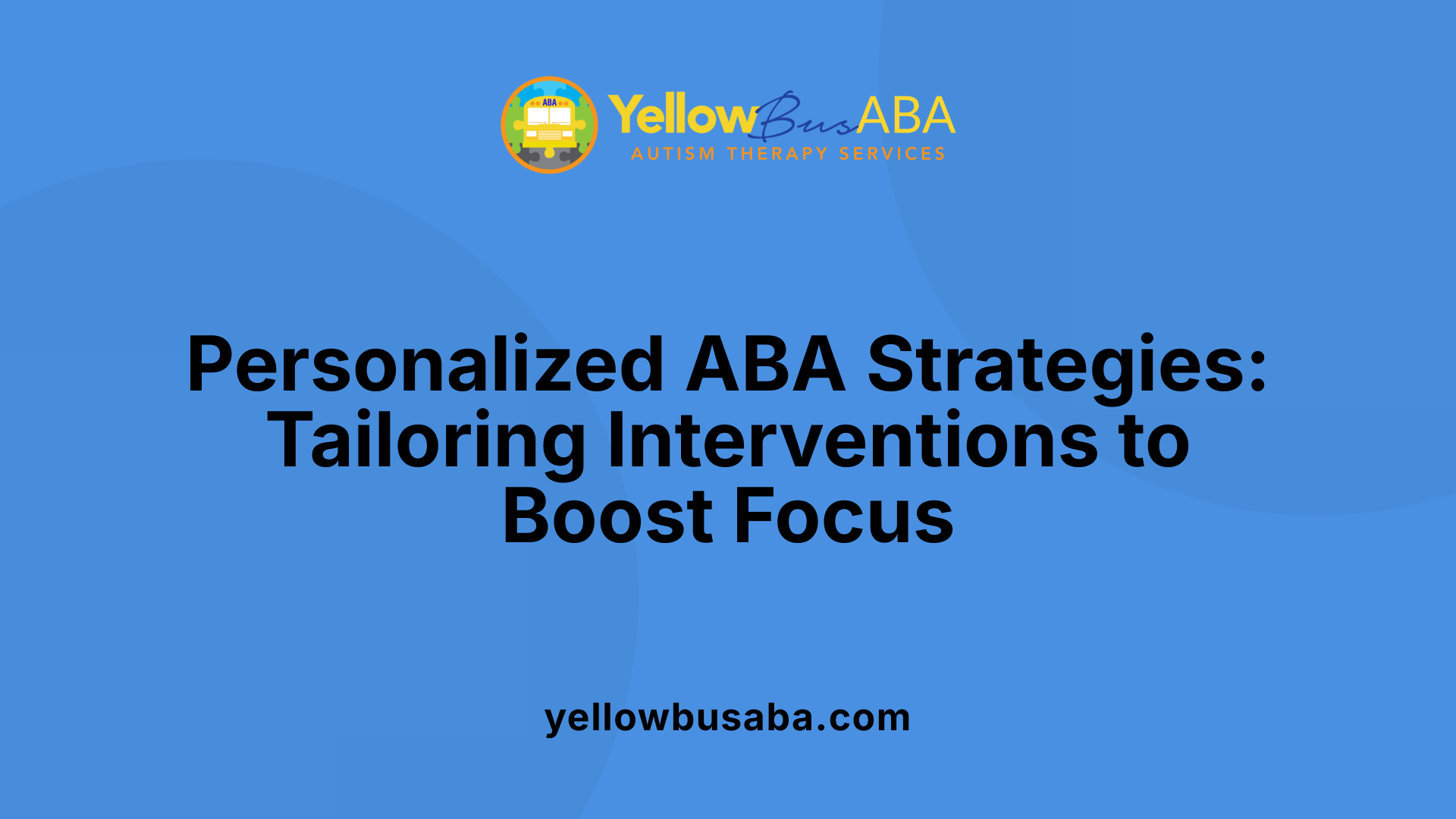
How effective is ABA therapy in helping children with autism develop focus and attention?
ABA (Applied Behavior Analysis) is widely regarded as an effective approach to improving focus and attention among children with autism. Its strength lies in evidence-based techniques such as prompting, reinforcement, and shaping, which reinforce attentive behaviors and gradually build a child's ability to concentrate on tasks.
Therapists tailor ABA programs to each child's unique needs, creating personalized intervention plans based on detailed assessments. These assessments, often conducted by a BCBA (Board Certified Behavior Analyst), involve observing the child's current behaviors, communication skills, sensory sensitivities, and social interactions. The information gathered guides the development of targeted strategies aimed at enhancing attention.
Ongoing data collection is a cornerstone of ABA therapy. Therapists track metrics such as duration of focused attention, response to prompts, success rates in task completion, and ability to transition smoothly between activities. This continuous monitoring allows for real-time adjustments to interventions, making therapy more responsive and effective.
Research supports the significance of early and intensive ABA intervention. Starting around ages 2 to 3, when neuroplasticity is high, can lead to substantial improvements in attention span, communication, and social skills. By systematically reinforcing desired behaviors and reducing distractions, ABA helps children learn to sustain attention over longer periods, participate more fully in educational and social settings, and develop independence.
Furthermore, combining structured activities—like sorting objects, storytelling, or physical exercises—with reinforcement techniques fosters an environment conducive to concentration. Incorporating visual cues, clear attention signals, and predictable routines further minimizes distractions.
Overall, ABA's systematic, individualized approach has demonstrated strong evidence for effectiveness in helping children with autism develop better focus and attention. Its emphasis on data, personalized goals, and reinforcement creates a foundation for meaningful progress in multiple areas, from communication to daily living skills.
Involving Caregivers and Teachers for Maximum Impact
What are the benefits of ABA therapy in enhancing concentration skills in children with autism?
ABA therapy provides structured and personalized interventions that actively improve attention and focus in children with autism. By employing methods like positive reinforcement, visual cues, and predictable routines, children learn to concentrate on tasks, follow instructions, and stay engaged for longer periods.
Early application of ABA, especially during critical developmental stages, results in notable progress in attention span and task engagement. These improvements also reduce anxiety around focusing, which can be a barrier for many children.
Furthermore, ABA helps develop vital social and communication skills that inherently support better attention in social interactions and learning environments. The combination of skill-building and behavior management creates a trusting therapeutic relationship, encouraging children to participate willingly and stay engaged.
The overall effect of ABA on attention is profound: children learn to develop a strong foundation of concentration skills, manage their behaviors more effectively, and participate confidently in educational and social settings.
How do caregiver and teacher involvement enhance ABA therapy outcomes?
Parents, caregivers, and teachers play a crucial role in reinforcing the skills learned through ABA therapy. Their consistent involvement ensures that behaviors and attention strategies are practiced across different environments, promoting generalization.
Training caregivers in reinforcement techniques helps them understand how to encourage desired behaviors at home and in school. For example, using praise, preferred activities, or tangible rewards can motivate children to focus and complete tasks, reinforcing the learning established during therapy sessions.
Moreover, caregivers and teachers are vital in maintaining routine consistency. Structured routines create a predictable environment, reducing distractions and fostering a sense of security, which is fundamental for developing sustained attention.
By actively participating in therapy, caregivers and teachers can facilitate more meaningful progress. They can adapt strategies to suit each child's unique needs, monitor attention levels, provide immediate positive feedback, and implement reinforcement plans effectively.
This partnership not only accelerates skill acquisition but also builds a supportive network that promotes generalization of attention skills across settings, leading to more consistent and lasting improvements.
Strategies for training caregivers for consistency
Training programs for caregivers focus on equipping them with practical skills to support ABA strategies daily. Key components include:
- Demonstrating reinforcement techniques: teaching how to effectively praise and reward desired behaviors.
- Educating on environmental control: organizing the home and classroom settings to minimize distractors.
- Using visual supports: employing visual schedules and cues to prompt attention and task completion.
- Practicing break and transition techniques: incorporating sensory or movement breaks to reset attention.
- Monitoring progress: keeping simple data on attention span and behavior to share with therapists.
Ongoing coaching, feedback, and collaboration with ABA professionals ensure that caregivers can confidently implement strategies. When families and teachers are well-trained and consistent, children have better opportunities to develop prolonged attention spans and independent task completion.
Through active involvement and tailored training, caregivers become essential partners in supporting children’s attention development, maximizing the benefits of ABA therapy across all aspects of their lives.
The Neuroplasticity of the Brain and Its Role in ABA Success
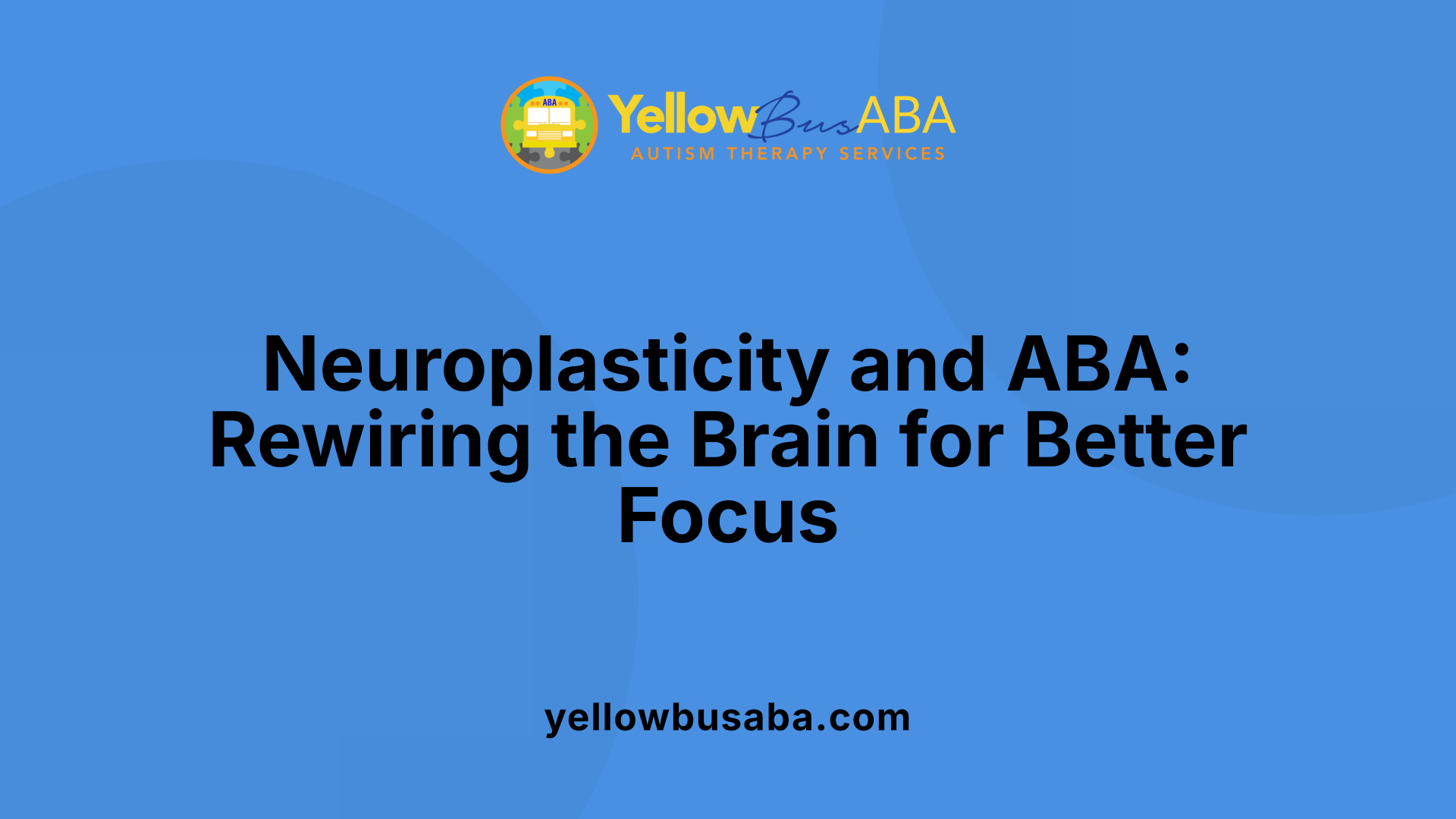
How effective is ABA therapy in helping children with autism develop focus and attention?
ABA (Applied Behavior Analysis) therapy has proven to be highly effective in fostering improved attention in children with autism. Rooted in evidence-based principles of learning and positive reinforcement, ABA employs various strategies such as prompting, shaping, and task analysis to encourage attentive behaviors.
One of the core strengths of ABA is its ability to create personalized interventions. By conducting assessments through observations and play-based evaluations, behavior analysts identify a child's unique strengths and areas needing support. This allows for tailored therapy plans that specifically target attention-related challenges.
ABA techniques like discrete trial training involve short, structured learning opportunities where children receive immediate feedback and reinforcement for focused behaviors. Repeating and reinforcing these behaviors gradually help increase their duration and consistency.
The structured routines in ABA settings, combined with visual cues and clear instructions, help children focus on one task at a time and reduce distractions. Moreover, using positive reinforcement such as praise, preferred toys, or activities motivates children to maintain their focus, as they associate concentration with positive outcomes.
Early intervention, around ages 2 to 3, is especially beneficial. It can significantly improve a child's long-term attention span and overall communication and social skills. This is because early intensive ABA therapy capitalizes on neuroplasticity — the brain's capacity to learn and rewire itself.
Research by Asadi et al. (2024) supports ABA's effectiveness, highlighting how structured learning with visual models and attention cues enhances focus. Therapists also track improvements through metrics like the duration of focused attention, the number of prompts needed, and the ability to transfer skills across settings.
Combining ABA with other therapies, such as speech and occupational therapy, creates a comprehensive approach to fostering sustained attention. For instance, sensory integration activities can reduce sensitivities, further enabling children to concentrate.
Finally, promoting interests, controlling the environment to minimize distractions, and incorporating age-appropriate activities like reading, physical exercises, games, and arts help reinforce focus skills over time.
In summary, ABA therapy supports children in developing stronger attention by breaking down tasks into manageable steps, reinforcing positive behaviors, and creating predictable and secure environments. These strategies leverage the brain's neuroplasticity, allowing children to learn new skills and improve focus in meaningful ways.
Holistic Approach: Incorporating Various Therapies and Family Support
How does ABA therapy support attention span development in children with autism?
ABA therapy plays a vital role in helping children with autism improve their attention spans by using evidence-based strategies rooted in positive reinforcement and systematic task analysis. Therapists design structured activities like sorting objects, memory games, and storytelling to capture children’s interest and gradually extend the time they can focus.
One of the strengths of ABA is its ability to tailor interventions to each child's individual needs. This personalization includes the use of visual supports and clear routines that make the environment predictable, helping to reduce anxiety and sensory overload which can interfere with focus.
By breaking complex skills into small, manageable steps and reinforcing desired behaviors, ABA helps children learn to regulate impulses and shift their attention more efficiently. Techniques like shaping — where successive approximations of a skill are reinforced — and task analysis create a scaffolded learning process. This not only enhances concentration but also promotes independence and social skills.
In addition, ABA incorporates sensory considerations, recognizing that sensory sensitivities can impact attention. Using sensory integration strategies alongside behavioral techniques can further improve alertness and reduce sensory distractions.
Recent research underscores the effectiveness of structured activities and visual cues in increasing attention and engagement. These interventions are complemented by the use of natural environments and real-life settings, which help children generalize their skills beyond therapy sessions.
Overall, ABA creates a personalized, engaging framework that fosters sustained attention development. This foundational skill supports broader learning, social interaction, and daily living independence, forming a comprehensive pathway toward improved quality of life for children with autism.
How does combining ABA with other therapies benefit children?
Integrating ABA with speech, occupational, and sensory therapies offers a more holistic approach to development. Speech therapy enhances communication skills—both verbal and non-verbal—that are crucial for social interaction.
Occupational therapy helps children develop fine motor skills and sensory processing abilities, addressing sensitivities that can hinder attention and participation.
Sensory integration therapy specifically targets sensory issues, creating a calming environment that supports focus and reduces overstimulation.
The collaboration among these therapies ensures that interventions work synergistically, addressing multiple aspects of a child's development simultaneously. For example, improving sensory processing through occupational or sensory therapy complements ABA techniques aimed at increasing attention and self-regulation.
This comprehensive approach ensures a more consistent and reinforcing environment, both at home and in educational settings, fostering greater progress.
The importance of family involvement and maintaining routines
Family involvement is central to the success of ABA therapy. Consistent routines at home reinforce the skills learned during therapy sessions and create a predictable environment that supports learning.
Parents and caregivers are trained to implement reinforcement strategies, use visual supports, and manage behavioral challenges effectively. This active participation helps generalize skills across various settings.
Establishing regular routines and incorporating familiar activities provide a sense of safety and stability, reducing anxiety and enhancing focus.
Furthermore, involving families ensures that interventions are meaningful and tailored to the child's daily life, increasing motivation and engagement.
In conclusion, a holistic autism intervention plan that combines ABA with speech, occupational, and sensory therapies, coupled with active family participation, creates a supportive, multi-dimensional framework. This approach not only boosts attention and learning but also promotes respect, safety, and independence for children navigating life with autism.
Conclusion: Empowering Children with Autism through Focused Interventions
How does ABA therapy improve attention and focus in children with autism?
Applied Behavior Analysis (ABA) therapy enhances attention by breaking tasks into manageable steps, helping children focus on one aspect at a time. This systematic approach allows children to gradually improve their concentration and endurance during activities. Structured ABA sessions follow predictable routines, reducing distractions and creating a safe environment where attention skills can develop effectively.
One of the core strategies in ABA is positive reinforcement. Children receive praise, toys, or access to favorite activities when they demonstrate focus. This not only motivates children to stay engaged but also helps them associate attention with positive outcomes, boosting their desire to concentrate on tasks.
ABA techniques such as Discrete Trial Training utilize short, structured learning opportunities with immediate feedback. These methods encourage repetition and reinforcement, which are essential for developing sustained attention and reducing distractibility. Recent research supports these approaches, indicating that visual supports and clear cues significantly improve children's ability to focus.
Furthermore, caregivers and teachers play a vital role in reinforcing attention skills across various settings. Consistent reinforcement, combined with environmental control—like minimizing background noise and managing sensory sensitivities—can significantly improve a child's capacity to concentrate.
By tracking attention metrics such as duration of focus and success rates, therapists can tailor interventions to each child's unique needs. This personalized approach ensures that progress is measurable and continuous.
What are the long-term benefits of early intervention and comprehensive strategies?
Starting ABA therapy early, typically around ages 2 to 3, offers significant advantages. Early intervention exploits neuroplasticity—the brain's ability to grow and adapt—leading to more substantial improvements in attention, communication, and social skills. When combined with comprehensive strategies that involve collaboration among therapists, parents, and educators, children receive a holistic support system.
Integrated approaches that include sensory integration, speech, and occupational therapies complement ABA interventions, addressing multiple developmental domains. For example, sensory processing support helps children manage sensitivities that may interfere with focus, while social skills training promotes better peer interactions.
Consistent, parent-implemented reinforcement at home and in community settings helps generalize skills learned in therapy. This consistency is crucial in translating improvements in attention from clinical sessions to everyday life.
In conclusion, early and comprehensive ABA interventions provide children with autism the tools to develop stronger attention spans, which are foundational for learning, social interactions, and independence. Over time, these targeted strategies foster respect, safety, acceptance, and autonomy, enabling children to participate more fully and confidently in all aspects of life.
Fostering Independence and Lifelong Focus
In summary, ABA therapy plays a crucial role in helping children with autism improve their ability to focus and concentrate. Through personalized, evidence-based strategies such as positive reinforcement, structured routines, visual supports, and sensory considerations, ABA addresses core attentional challenges. Not only does it foster immediate skill development, but it also builds a foundation for lifelong learning, social participation, and independence. Early intervention and continued caregiver involvement are integral to maximizing outcomes. As research continues to validate its effectiveness, ABA remains a cornerstone in supporting children with autism to reach their full potential in focus, communication, and social engagement.
References
- Improving Attention Span in Children with Autism Through ...
- Applied Behavior Analysis – Giving Kids The Skills They ...
- Focus and Concentration in Children with Autism
- ABA Therapy and Attention Span: Key Benefits Explained
- Understanding ABA ASD: Key Benefits for Autism Treatment
- How ABA Therapy Can Improve Communication Skills in ...
- Improving Attention Span in Autism Through School ...



.jpg)

.avif)
